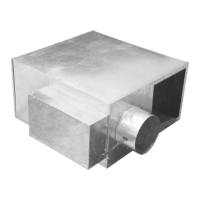7
Fig. 8 — Typical Power Connections for Fan Powered Units with 3-Stage Electric Heat
Step 4 — Set Up System and Calibrate
GENERAL
The parallel fan powered terminals (45M, 45N, and 45R) are de-
signed to provide varying quantities of cold primary air to a space
in response to a thermostat demand for cooling. For a heating de
-
mand, the fan will operate to supply ceiling plenum air to the
space. For units equipped with a heating coil, the heater will oper
-
ate as required to meet a heating demand.
The series fan powered terminals (45J, 45K, and 45Q) are de-
signed to provide a constant airflow to the space. The air supplied
to the space is a mixture of primary air and ceiling plenum air. The
fan speed is adjusted to provide the required airflow to the space.
In response to a cooling demand from a thermostat, the damper
will increase the amount of cold primary air while reducing the
amount of ceiling plenum air to decrease the temperature of the air
being delivered to the space.
Most terminal control packages provide pressure compensation to
allow pressure independent operation of the primary air damper,
regardless of changes to the available static pressure in the supply
ductwork. To balance the unit it is necessary to set both the mini
-
mum and maximum airflow set points of the controller. The many
types of control options available each have specific procedures
required for balancing. Refer to the submittal information for these
requirements.
SET POINTS
Maximum and minimum airflow set points are normally specified
for the job and specific for each unit on the job. Default set point
values are provided by the factory and can be reset to the specific
requirements in the field. The fan speed must be field adjusted af
-
ter all discharge ductwork and diffusers have been installed.
Field Adjustment of the Maximum and Minimum Airflow Set
Points
Each fan powered terminals unit is equipped with an airflow sen-
sor installed in the primary air inlet which measures a differential
pressure. The relationship between the airflow probe pressure and
the corresponding airflow is shown in the Flow Probe Graph. See
Fig.
9. This chart is attached to each unit.
SYSTEM CALIBRATION OF THE INLET AIRFLOW
SENSOR
To achieve efficient pressure independent operation, the velocity
sensor and linear averaging flow probe must be calibrated to the
controller. This will ensure that airflow will be accurate for all ter
-
minals at system start-up.
System calibration is accomplished by calculating a flow coeffi-
cient that adjusts the pressure fpm characteristics. The flow coeffi-
cient is determined by dividing the flow for a given unit (design
air volume in cfm), at a different velocity pressure of 1.0 in. wg,
by the standard pitot tube coefficient of 4005. This ratio is the
same for all sizes, if the standard averaging probe is used.
Carrier inlet areas are shown in Table 8, which illustrates the de-
sign air volume. It can be determined from Table 8 that the aver-
age design air velocity for units is equal to 2660 fpm at 1.0 in. wg.
Determine the design air velocity by dividing the design air vol-
ume (the flow at 1.0 in. wg) by the nominal inlet area (sq ft). This
factor is the K factor.
LEGEND
AFS — Airflow Switch
CAP — Capacitor
SCR — Silicone Control Rectifier

